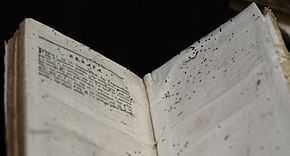Bookworm (insect)

Bookworm is a popular generalization for any insect which supposedly bores through books.
Actual book-borers are uncommon. Both the larvae of the death watch beetle (Xestobium rufovillosum) and the common furniture beetle (Anobium punctatum) will tunnel through wood and paper if it is nearby the wood.
A major book-feeding insect is the book or paper louse (also known as booklouse or paperlouse). These are tiny (under 1 mm), soft-bodied wingless Psocoptera (usually Trogium pulsatorium), which actually feed on microscopic molds and other organic matter found in ill-maintained works (e.g., cool, damp, dark, and undisturbed areas of archives, libraries, and museums), although they will also attack bindings and other book parts. It is not a true louse.
Chief Secretary for Ireland from 1907-1916, Augustine Birrell once recounted a situation in which a bookworm had eaten through to the 87th page of a fifteenth-century vellum book. By the twentieth century, chemical book composition thwarted much of the damage done to books by various types of book-boring insects.[1]
Two moths, Tineola bisselliella and Hofmannophila pseudospretella, will attack cloth bindings. Leather-bound books attract various other consumers, such as Dermestes lardarius and the larvae of Attagenus unicolor and Stegobium paniceum. The bookworm moth (Heliothis zea or H. virescens) and its larvae are not interested in books: the larvae are pests for cotton or tobacco growers as the cotton bollworm or tobacco budworm.
See also
- Booklouse
- Woodworm
References
- ↑ Murray, Stuart (2009). The Library: An Illustrated History. New York, NY: Skyhorse Publishing. p. 198.
- "John Francis Xavier O'Conor, Facts about bookworms: their history in literature and work in libraries (New York: Francis P. Harper, 1898.)
- John V. Richardson Jr., “Bookworms: The Most Common Insect Pests of Paper in Archives, Libraries, and Museums”
- "Timber Borers - Anobium & Lyctus Borers"
- Thomas A Parker "Study on integrated pest management for libraries and archives" - prepared by Thomas A Parker for the General Information Programme and UNISIST (Paris: Unesco, 1988)